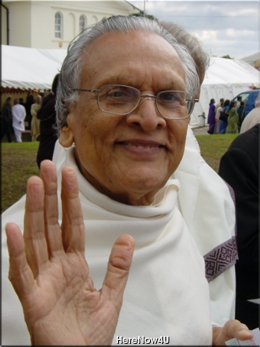
Friends,
I am very happy to be with all of you to share some experiences, insights and thoughts of the great enlightened, Vardhaman Mahavira. He was a living example of Awareness, Reverence for life and Non-violence. Through his living, he showed us that we are rich if we are aware of our richness and we are not poor until we think we are poor.
Jain way is a religion of reverence for life, a religion that does not emphasize dogma or rituals. It does not rely on any outside forces. It is an internal search and vigilance.
Let us look at the word Jain. It comes from the Sanskrit verb ji, which means 'to conquer'; one who has conquered himself or herself is known as a Jina. A Jina has nothing to win and nothing to lose; he is the conqueror, inside and outside. Jina means one who has reached inner harmony, inner richness, where there is no conflict. The followers of a Jina are known as Jains, and the philosophy, which teaches how to bring an end to the fighting, how to create harmony and enrich oneself with the beauty of inner awareness is the Jain Way of Living.
According to the Jain tradition, the first man who found the inner peace, inner balance and reached the fullness of life is known as Adinath. This too is a Sanskrit word - Adi and nath. Adi means the beginning and nath means Lord. The Lord of the Beginning, not of the world but of inner awareness. He was the first man on the ladder of evolution in this cycle of time to realize the awareness of peace and richness of living, and of experiencing the summit of freedom where there is no struggle, no war, no need to go anywhere, no desire even to reach for anything. He realized that all the wealth and treasure is within. He was born before historical dates began. Some people refer to him as Adam. He was the man who first perceived the inner wealth of mankind.
There are 24 such Tirthankaras, and the first one was Adinath, thousands and thousands of years ago. The 22nd Tirthankara was known as Neminath. He was a cousin of Krishna. According to historians, they lived around 11,000 B.C. Neminath was a compassionate soul who left home after seeing the agony of animals about to be butchered for his wedding feast and ceremony. When he saw the animals crying out in pain and fear, he thought, "All this misery and torture for a marriage feast? A joy for one causes pain to so many? For a few hours of pleasure? This is not fair. No, I do not want this marriage.' So he turned his chariot around and went away to Mount Girnar. There he worked for inner peace.
His beloved Rajul was told that Neminath, her beloved, had seen the pain of the animals and chose to leave the material world for enlightenment. She also felt Reverence for Life and went with him to work for enlightenment. Eventually, both became enlightened in that life.
In the series of Tirthankaras, Mahavira was the 24th and last one. His other name was Vardhaman, and he was a prince who was born 12 years before Buddha in 599 B.C. He lived for 30 years in the palace, but he saw the pain, sorrow and suffering of the world outside. And he thought, "How can I enjoy living in a palace while mankind is suffering? What is the meaning of these worldly pleasures, which have diminishing returns? Can I not use my life to bring the light of enlightenment to all living beings in order to show the cause of sorrow and suffering?" So, he asked his older brother Nandivardhan to give his consent to him to renounce the world. At first, he was unwilling to separate from his brother but seeing Vardhamans deep longing, he consented.
So, Vardhaman renounced the world of attachment and went into the world of nature, where birds were singing, brooks were flowing, and the fresh air was invigorating. In this natural atmosphere, he started a journey of twelve years to purify his body, mind and soul - purifying his body with austerity and fasting; his speech with silence; his mind with meditation. In the height of this purification, he found his freedom and experienced the pure Self, the pinnacle of enlightenment.
When we reach this height of enlightenment, we see that there is nothing outside to reach. We have all what we need but it is covered with impure vibrations of anger, resentment, hatred and violence. And so we are not with the Self and that is why we think we should go somewhere, get something, and reach something - but the reaching is inside, not outside. Our senses desire comfort and sensual pleasure, and our mind is busy in collecting innumerable objects. This creates turmoil, and then our speech is not in tune with our senses and mind, so it creates dichotomy. In this dichotomy we do not know why and what we are.
Vardhaman worked with himself, and his life became a laboratory for purification. He researched life for twelve and a half years with the help of fasting, silence and meditation, and what he found is called Kaioalya Gnana, pure knowledge. He became omniscient; nothing remained to be known. He knew himself completely.
When we don't know ourself, we want to know many things, but when we know ourself, nothing is left to be known. In that state of fulfillment, we know, "We are where we are. We are incognito God. We have freedom to choose." In that moment all the joy of spirit opens into fullness and we experience the unlimited life.
Why do we fast? Because it purifies the senses, clears away the dirt, which covers our purity. But we do not fast to reduce the body to nothingness; we fast with balance. If the strings of a sitar are very tight, the tone is harsh. If they are very loose, then they do not have any sweetness in the music. Our body is like a sitar; you have to tune it properly. If you fast too much, life becomes harsh and you become cranky. If a person uses sensual pleasure too much, his life is diluted and he or she becomes a house of disease. That is why one has to be in tune like the sitar. That is the art of fasting.
By silence, we mean not only speech, but silence in thought also. Sometimes thoughts speak louder than words. They can create a riot inside. To bring silence in thoughts is the greatest art.
Meditation is used to reach that state in which you know who is dwelling in this body. Who sees through these eyes? Who hears with these ears? Who smells with this nose? Who tastes with this tongue? Who touches with hand? Who knows with these senses and this mind? To know who knows is meditation. To reach this last point is to know who knows.
From the age of 30 to 42 years Mahavira worked in this inner laboratory. And then after enlightenment, for 30 years he shared his thoughts, his feelings, his experiences of reverence for life, and his insights. This sharing was his joy, the pure unpolluted bliss.
 Gurudev Chitrabhanu
Gurudev Chitrabhanu
